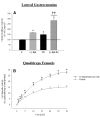(-)-Epicatechin combined with 8 weeks of treadmill exercise is associated with increased angiogenic and mitochondrial signaling in mice
- PMID: 25821434
- PMCID: PMC4358069
- DOI: 10.3389/fphar.2015.00043
(-)-Epicatechin combined with 8 weeks of treadmill exercise is associated with increased angiogenic and mitochondrial signaling in mice
Abstract
The purpose of this study was to conduct an 8 week endurance training program with and without (-)-epicatechin treatment and to determine whether there is a possible cumulative effect on protein markers of angiogenesis and mitochondrial biogenesis. Thirty-four 14-month old male mice (C57BL/6N) were randomized into four groups: control (C); (-)-epicatechin only ((-)-Epi); control with endurance training (CE); and (-)-epicatechin with endurance training ((-)-Epi-Ex). Mice in the training groups performed treadmill exercise for 8 weeks (5 × /week for 60 min/session), whereas mice in the (-)-epicatechin group received 1.0 mg/kg of body mass twice daily during the training period. At 8 weeks, distance ran on the treadmill increased by 46, 69, and 84% in the (-)-Epi, CE, and (-)-Epi-Ex groups, respectively compared to the control group (p < 0.001 for all comparisons). Furthermore, the (-)-Epi-Ex group had significantly higher exercise capacity than the (-)-Epi and CE group. For angiogenic regulators, the (-)-Epi-Ex group had significantly higher VEGF-R2 protein expression with a concomitant reduction in TSP-1 protein expression than the exercise group. Interestingly, FoxO1 protein expression was significantly reduced for all three experimental groups compared to the control group. Protein markers such as PGC-1β and TFAM were significantly higher in the (-)-Epi-Ex group compared to the three other groups. These findings suggest that (-)-epicatechin treatment combined with 8 weeks of endurance training provide a cumulative effect on a number of angiogenic and mitochondrial signaling which functionally translates to enhanced exercise tolerance.
Keywords: exercise tolerance; fatigue; mitochondrial proteins; mouse model; muscle; skeletal.
Figures




Similar articles
-
(-)-Epicatechin enhances fatigue resistance and oxidative capacity in mouse muscle.J Physiol. 2011 Sep 15;589(Pt 18):4615-31. doi: 10.1113/jphysiol.2011.209924. Epub 2011 Jul 25. J Physiol. 2011. PMID: 21788351 Free PMC article.
-
Similar skeletal muscle angiogenic and mitochondrial signalling following 8 weeks of endurance exercise in mice: discontinuous versus continuous training.Exp Physiol. 2013 Mar;98(3):807-18. doi: 10.1113/expphysiol.2012.070169. Epub 2012 Nov 23. Exp Physiol. 2013. PMID: 23180811
-
(-)-Epicatechin Attenuates Degradation of Mouse Oxidative Muscle Following Hindlimb Suspension.J Strength Cond Res. 2016 Jan;30(1):1-10. doi: 10.1519/JSC.0000000000001205. J Strength Cond Res. 2016. PMID: 26382133
-
(-)-Epicatechin maintains endurance training adaptation in mice after 14 days of detraining.FASEB J. 2012 Apr;26(4):1413-22. doi: 10.1096/fj.11-196154. Epub 2011 Dec 16. FASEB J. 2012. PMID: 22179525 Free PMC article.
-
Endurance Exercise and the Regulation of Skeletal Muscle Metabolism.Prog Mol Biol Transl Sci. 2015;135:129-51. doi: 10.1016/bs.pmbts.2015.07.016. Epub 2015 Sep 5. Prog Mol Biol Transl Sci. 2015. PMID: 26477913 Review.
Cited by
-
Mitophagy Transcriptome: Mechanistic Insights into Polyphenol-Mediated Mitophagy.Oxid Med Cell Longev. 2017;2017:9028435. doi: 10.1155/2017/9028435. Epub 2017 May 25. Oxid Med Cell Longev. 2017. PMID: 28626500 Free PMC article. Review.
-
(-)-Epicatechin Is a Biased Ligand of Apelin Receptor.Int J Mol Sci. 2022 Aug 11;23(16):8962. doi: 10.3390/ijms23168962. Int J Mol Sci. 2022. PMID: 36012227 Free PMC article.
-
Mitochondrial Transplantation's Role in Rodent Skeletal Muscle Bioenergetics: Recharging the Engine of Aging.Biomolecules. 2024 Apr 18;14(4):493. doi: 10.3390/biom14040493. Biomolecules. 2024. PMID: 38672509 Free PMC article.
-
Pterostilbene Enhances Endurance Capacity via Promoting Skeletal Muscle Adaptations to Exercise Training in Rats.Molecules. 2020 Jan 2;25(1):186. doi: 10.3390/molecules25010186. Molecules. 2020. PMID: 31906449 Free PMC article.
-
New Trends to Treat Muscular Atrophy: A Systematic Review of Epicatechin.Nutrients. 2024 Jan 22;16(2):326. doi: 10.3390/nu16020326. Nutrients. 2024. PMID: 38276564 Free PMC article.
References
-
- Allen D. L., Harrison B. C., Maass A., Bell M. L., Byrnes W. C., Leinwand L. A. (2001). Cardiac and skeletal muscle adaptations to voluntary wheel running in the mouse. J. Appl. Physiol. 90, 1900–1908. - PubMed
LinkOut - more resources
Full Text Sources
Other Literature Sources
Research Materials
Miscellaneous

